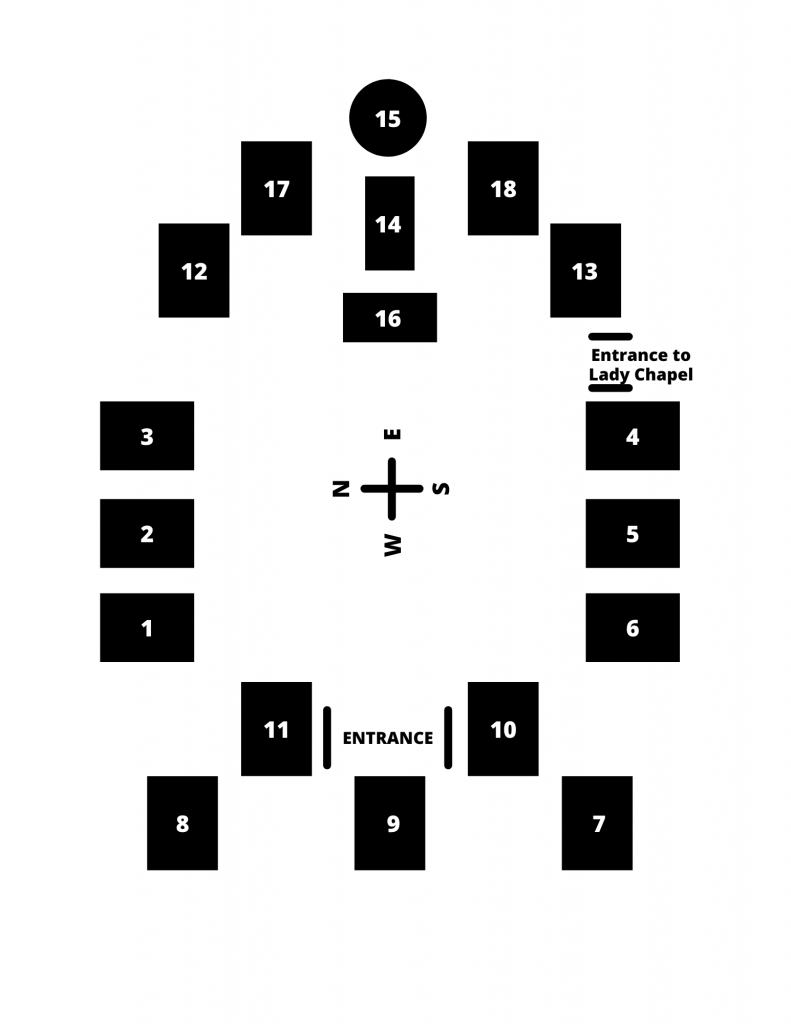
The main chapel is dedicated to the Holy Spirit. The paintings are of the Nine Gifts of the Holy Spirit, which cannot be earned or bought but must be given and received. In Japan, there is an elaborate form for giving and getting gifts. In return for a gift received, you give a gift that must be to a minute degree better than the one received. But here we have great difficulty receiving a gift. We find it hard to accept a gift and hard to give one without condescension.
The nine gifts of the spirit are Agape, Temperance, Eros, Self-Discipline, Faith, Hope, Holy Poverty, Gentleness, and Joy. All gifts are to be seen as one gift because all are interconnected. Christ says, “I will send you a comforter,” which is the Holy Ghost, which is always with us if we listen. But none of the gifts of the spirit can stand alone. We cannot have hope without faith or faith without hope, and neither can be absent if you have love; and there cannot be love without hope and faith, and so on. None of the gifts can stand alone, and none of them can be omitted. Each is its own self but is absolutely tied to all the others.
1. Agape
Virgin and Unicorn
Compassionate Love [Sacrifice]
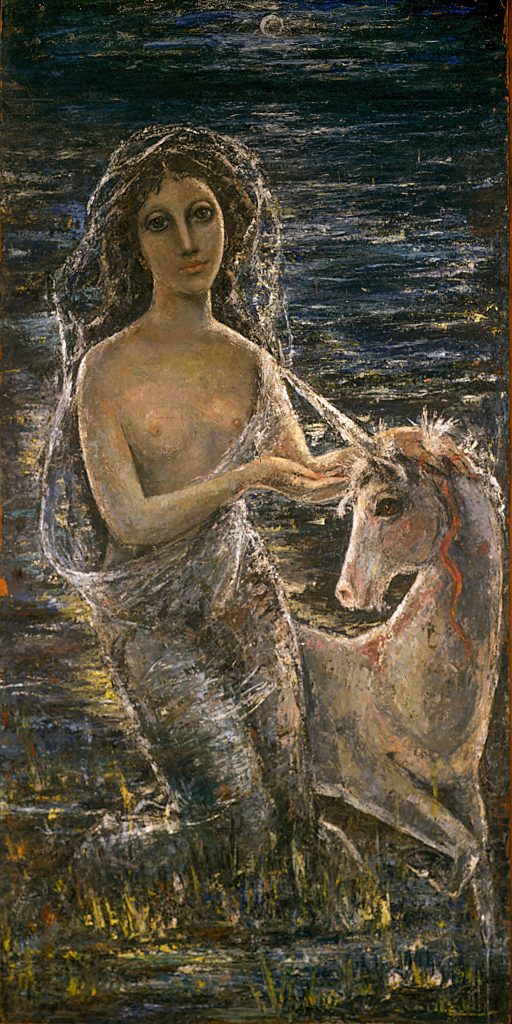
2. Temperance
Angel of Temperance
Mixing hot and cold (waters, colors)
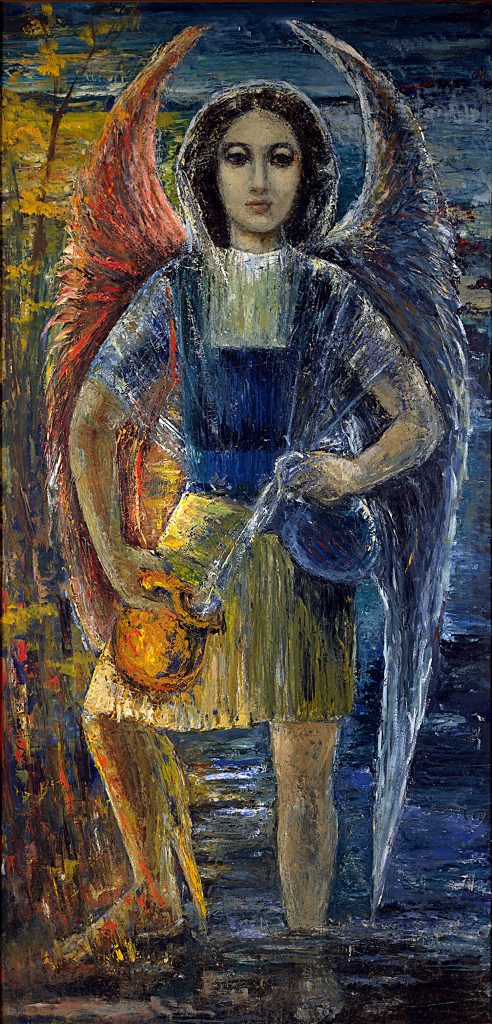
3. Eros
Virgin and Lion
Desiring love [Power]

Paintings 1 and 3 are based on Psalm 22:21: “Save me from the lion’s mouth: for thou hast heard me from the horns of the unicorns.” Temperance (Painting 2) is difficult to practice in our time. It is not recognized as a gift. But without temperance, all gifts become destructive. For example, compassionate love without the other gifts can reduce the world to a sea of sentimentality. Eros without the others reduces one to being at the mercy of one’s desires.
4. Self-Discipline
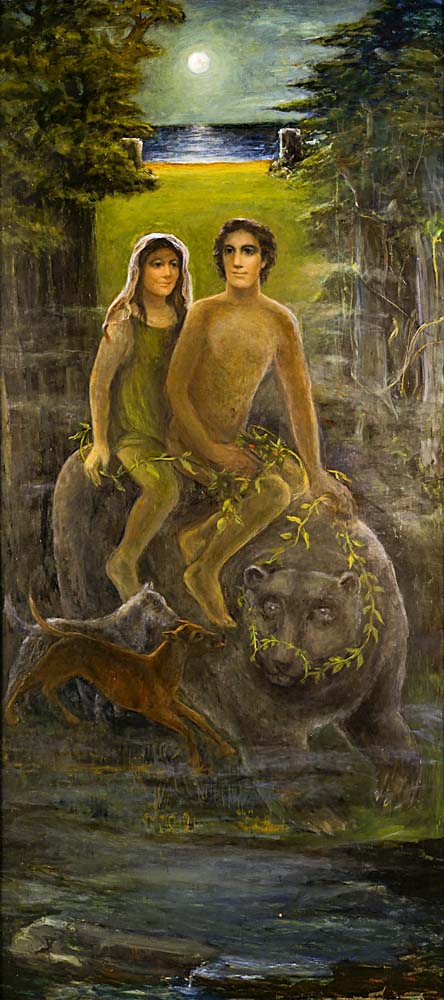
The Discipline of Desire (Desire disciplines; Desire as discipline)
Man and woman, the two aspects of human beings, mounted on a bear, which stands for the body—the body as vehicle—the only vehicle we have. The bear is animality: dignified, serious, powerful, omnivorous. A skinned bear looks like a man. The bear is driven by garlands (passion flower vine) because we manage our bodies by desire; desire makes people undergo the severest disciplines. (There is no excellence without discipline, and there is no self- discipline; there is only being disciplined by our desire.) The yapping dogs are the funny, trivial, silly aspects of the animal/vehicle body, the things our bodies do as if by themselves, to our disgust or frustration, like nail-biting.
5. Faith
Saint Mary Magdalene and Saint Mary of Egypt
The two most worshipped beings in the Middle Ages were the Madonna, worshipped as a human being who was not a sinner, and Mary Magdalene, worshipped as a human being who was a sinner.
Mary Magdalene lives a rich, fancy, high-society life as a widow in a late Hellenistic world devoted to filling all appetites. (The ointment she uses on Christ’s feet tells us she is wealthy—and she sacrifices it to the divinity she recognizes in Christ.) She looks through a window and sees Christ talking to the disciples and that glance instantly converts her. She becomes an ascetic, living in France in a cave. Her whole life is shattered and a new life begins with one glance. She is always represented with an incense box.
In this painting, Mary Magdalene is in conflated with St. Mary of Egypt. She also was rich and gave up everything on her conversion and wanted to go away from the world, which equaled Rome. To get away from Rome you had to go either to Ireland (never conquered by Rome) or to Egypt, which was big enough to allow you to do what you wanted. She went to Egypt and became an ascetic. She is always represented with a skull, which she contemplates all her life.
We all know that a bad means can corrupt or destroy a good end. But I have the theory that if the end is great enough, it can cleanse the means, retroactively. St. Mary of Egypt has given up everything and is left with no means to get to Egypt, so she works as a prostitute to get there. But her faith cleanses the means she uses to fulfill her faith. And it says in the Bible that Mary Magdalene was forgiven because her sins were many (Luke 7:37-50). Because it says this, she became identified with the sin of prostitution, though probably she was really a Hetaira, a highly educated courtesan. But she becomes the patron saint of prostitutes.
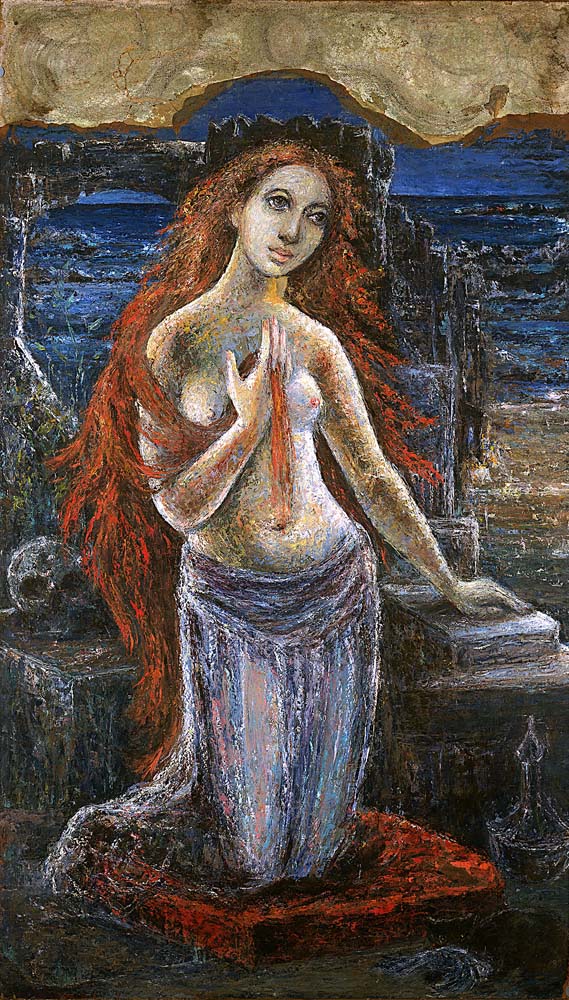
6. Hope
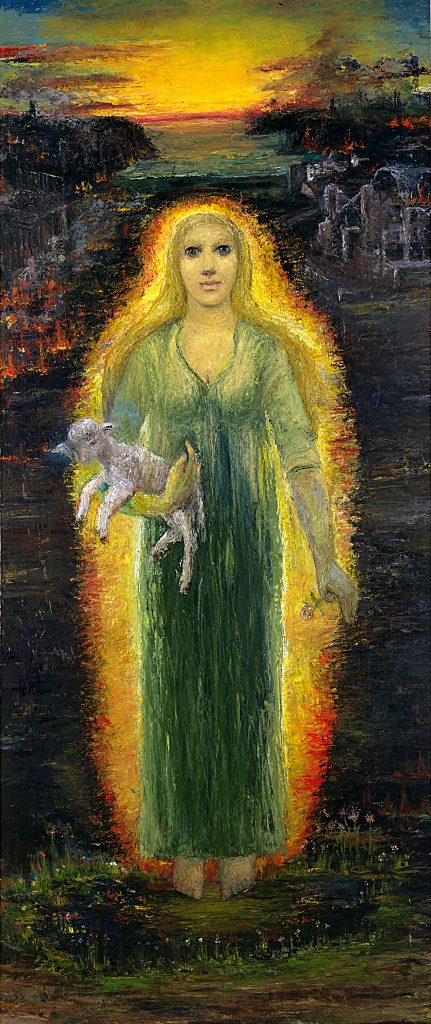
The woman clothed in green, the color of hope, stands in a nimbus of light, holding the lamb of innocence, her feet in water where flowers bloom as the world around her burns.
The painting was inspired by pictures of the Malibu fires. Malibu was created by Hollywood. The people who lived there were movie people, the only real aristocracy in the modern world, associated with money, fame, the ability to command attention. So the burning of their safe, sacred area, Malibu, was a great sign.
We live in a period without hope. When I was a girl, people had hope. There were apostles—for Christianity, Marxism, anarchism, Dewey and the colleges. People felt “If we can only do this, things will be ok.” But now no one has hope; no solutions are believed in.
I wanted the image of hope to have a background of everything falling apart and being destroyed, in front of which is hope—not fatuous but with full recognition of the dark around her. But she has her feet in water, near flowers that bloom, holding a lamb, all creatures that give us hope. My friend Theresa Ellis said about the figure of Hope, “She has gathered the fires of destruction to make light.”
7. Holy Poverty
One great gift of the spirit used to be called holy poverty. The opposite of greed—but we have no word for it. It is the sense of having enough, of sufficiency, the sense that what you are and what you are doing is right, is enough, is the will of God. Our society is all about making us dissatisfied with what we are and do and have, giving us images of what we are not and what we aspire to be. For example, Michael Jackson turning himself from a cute African- American boy into an upper-class, sophisticated white girl. We have given ordinary people the power to remake or reinvent themselves entirely.
The woman in the painting has the bare essentials in a hostile environment of rocks, canyons, etc.: a staff to fend off or get over the worst obstacles, lunch (something to eat), and a faithful dog (love and companionship)—that is, the absolute minimum by which we can live perfectly happily without greater need. Love, a journey (that is, a sense of moving somewhere, of becoming something), and protection— these are the necessities. But she doesn’t want or need anything more.
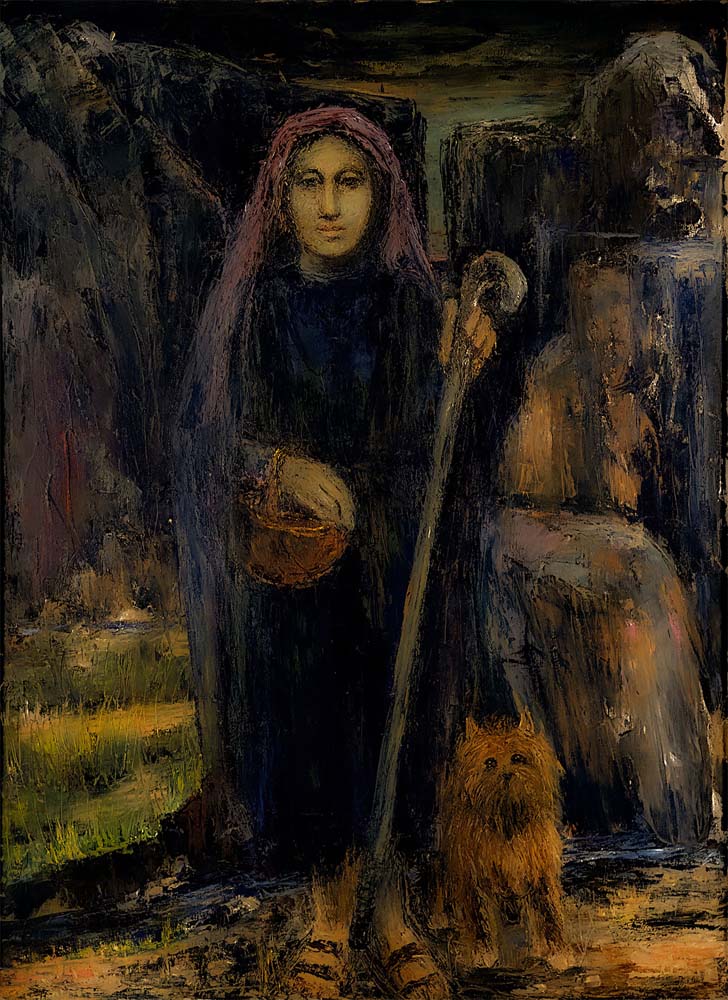
8. Gentleness
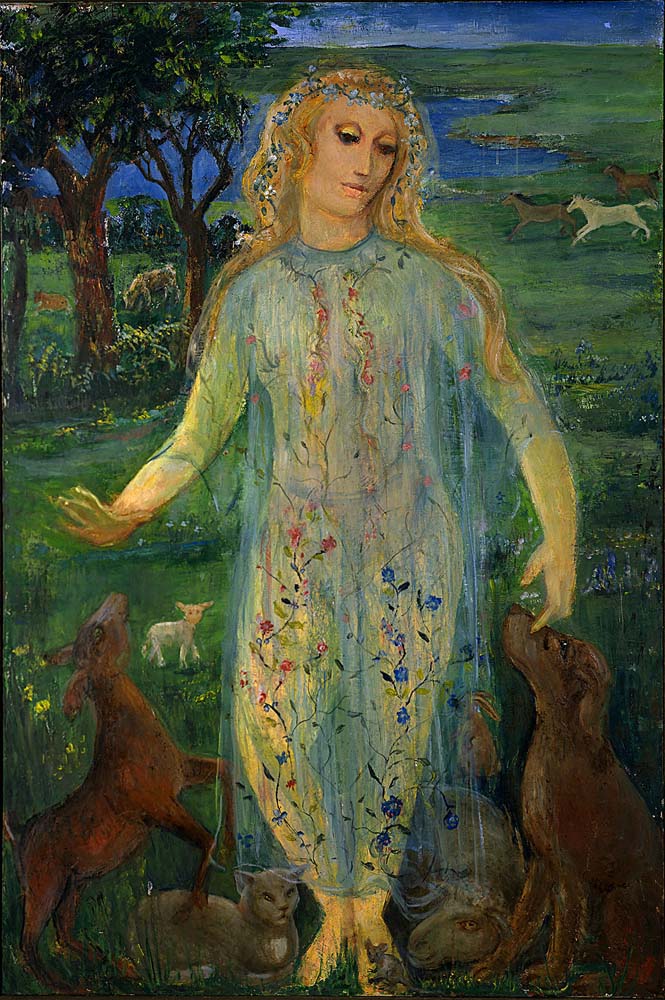
Cruelty to animals, to any creatures who are vulnerable, leads to every other kind of cruelty. It is a sin against love and against life itself.
9. Joy
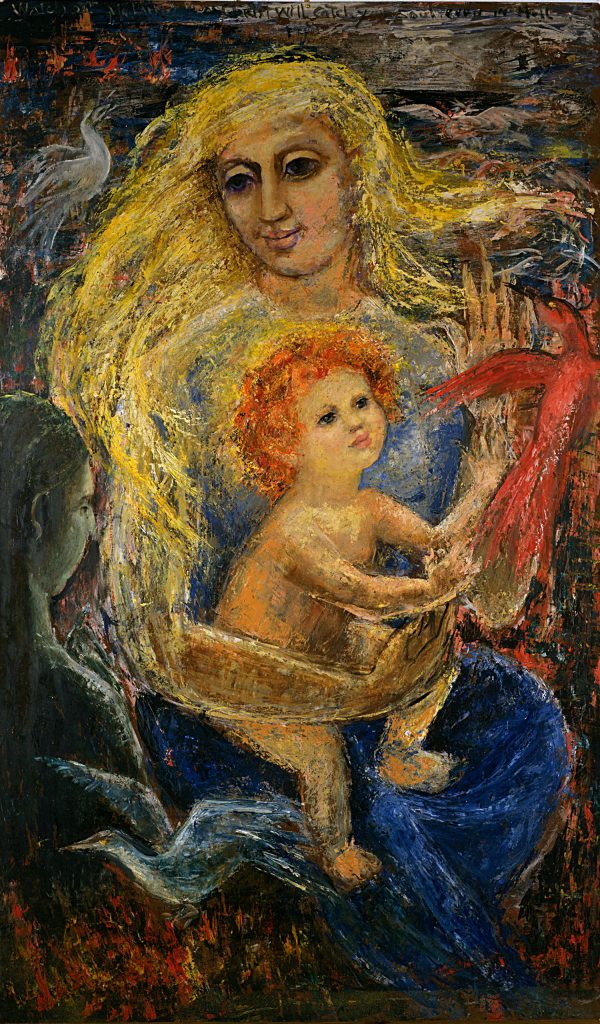
The painting in this spot now [as of August 17, 1998] is not to be here permanently. I intend to paint a painting depicting the gift of joy, and I’m working on finding an image that will work. This painting of the Holy Family, temporarily in the place reserved for Joy, was inspired by a professor who didn’t want a faculty meeting to be held at 11:00 a.m. on Sunday morning because he felt it would be too much like church. A person who demonizes religion so much is particularly vulnerable to it. Inscribed at the top of the painting is “Watch out, dear professor, Christ will get your soul even in hell.”
10 & 11: The Death and Resurrection of the Dragon
The capacity to see darkness is also a gift. There is a dark nature of everyone that must be recognized or it will destroy. The death of the dark nature within us, represented by the dragon, is resurrected as power, the dragon under government. The figure in 10 is a young person, neither male nor female but universal, slaying the dragon. The figure in 11 stands on the dragon which is swallowing its own tail. She holds the resurrected dragon in her left hand in a cup and a mirror in her right hand. The recognition of the darkness gives power toward light.
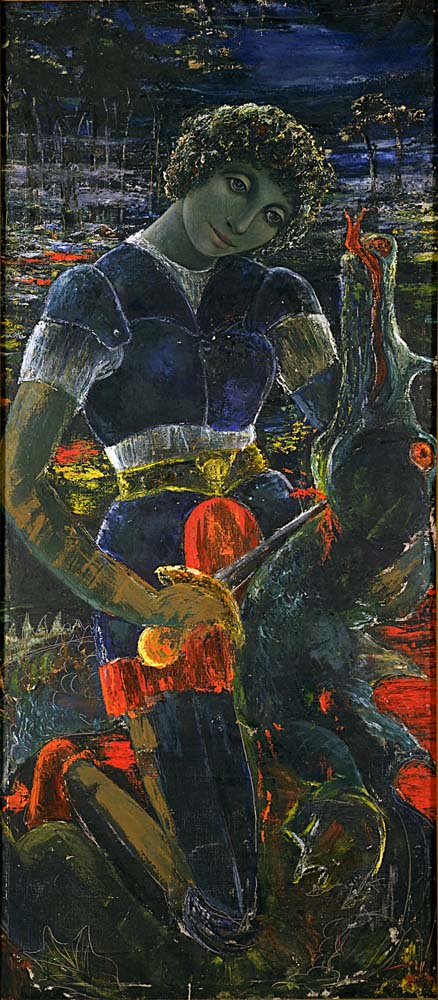
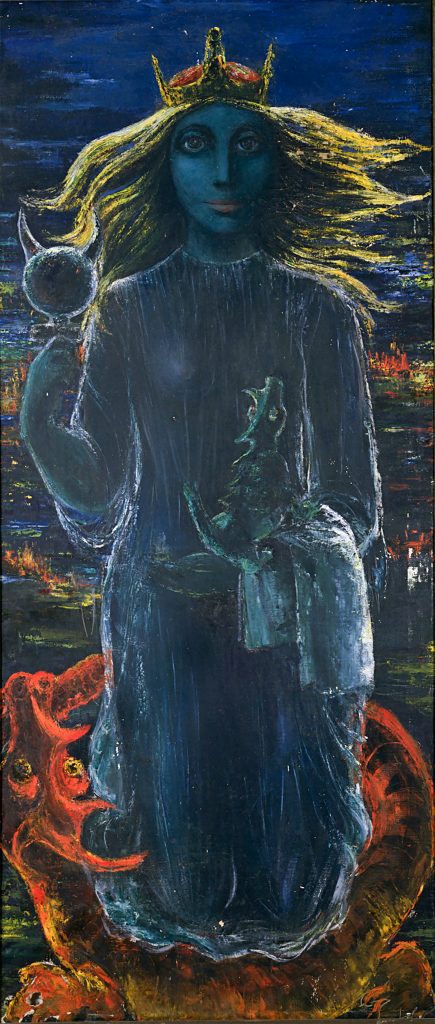
12. Mary Had a Little Lamb Slain Before the Foundation of the World

Both 12 and 13 were painted fifty years ago (in the house on Georgina Street in Santa Monica) in the enamel paint my son Michael was using on his model airplanes.
The painting is of “Mary had a little lamb, slain before the foundation of the world.” The lamb has its throat cut. (I once had a sick lamb I tried to save, but it died. So the lamb in the painting is a portrait.) The Mary figure is a figure of the feminine aspect of the divine, the Shekhina.
The name “Mary” has influenced me all my life. It is a Catholic name in a Protestant world. My father loved Robert Burns and used to recite his poems.
All the Marys in Burns are dead. I believed that all references to any Mary were about me. In the Christmas pageant put on by in the fourth grade at my school in Chicago (The University School for Girls, 1106 Lakeshore Drive), they made me play the Virgin, for which I had to memorize and sing the Magnificat. (I’ve never had stage fright because I couldn’t see. I didn’t get glasses till later.) So I memorized and sang it.
13. Saint Michael
My son is named Michael because I’m devoted to the archangel Michael, who carries the scales for the judgment at the end of the world. The figure is not Joan of Arc, as some people think, but the angel is neither male nor female, because angels neither marry nor are given in marriage [Matthew 22:30]. “Angel” means messenger. So an angel always has to do with the divine and the human. They are more general than human beings, who are more specific. Angels are more platonic beings.
14. The Unicorn Tapestry
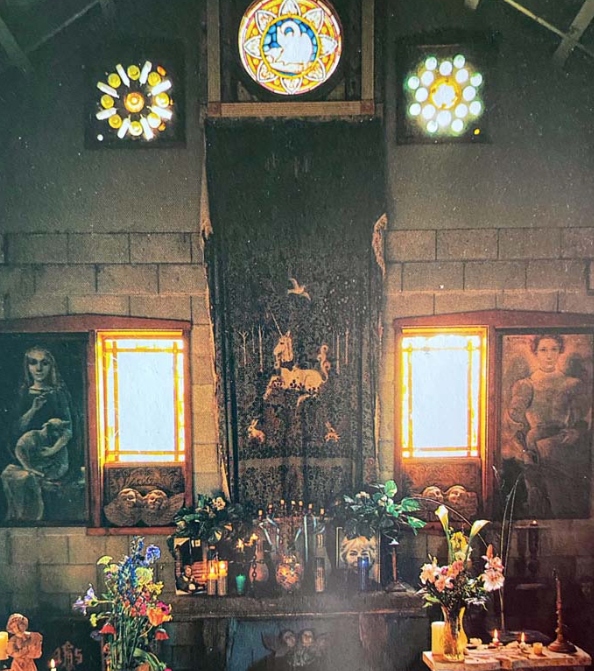
It is not a tapestry but a bedspread I had with no good use for it until the chapel was built. It is an example of the marvelous modern ability to make things inexpensively and easily that used to take tremendous work. Now you could buy all the unicorn tapestries for $20 apiece. I’m delighted to have this bedspread because it is a very satisfying reproduction. (The unicorn is a symbol of sacrifice, therefore of Christ.)
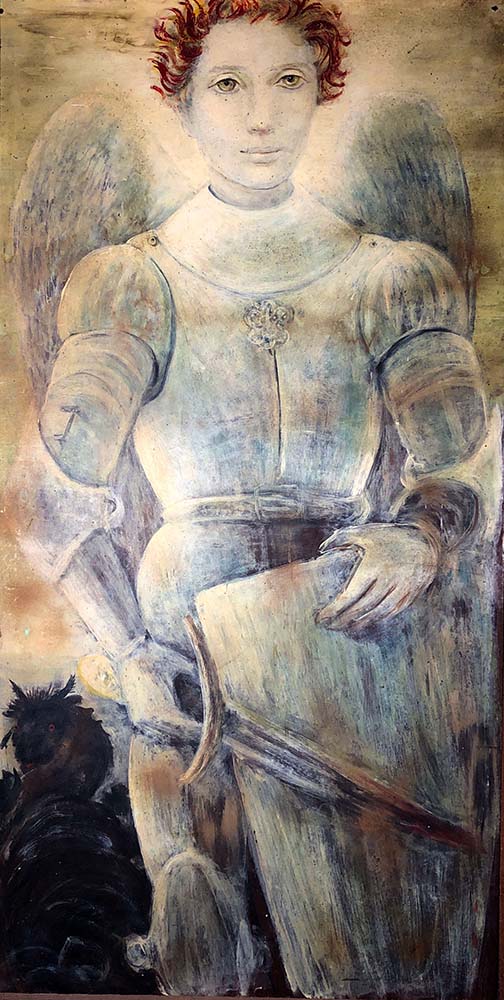
15. The Pelican Window
Having this window is the result of a great piece of providence. Years ago, Bruce was interested in stained glass and found in Los Gatos a group of three windows from an old church. Friends said I ought to have them, but another student arranged to buy them for the Cowell College (UCSC) instead. One was installed in the Junior Common Room at the college, and the others remained neglected at the provost’s house and later in a basement of the college. Nearly thirty years later, just when I was building this chapel, Angie Christman called from Cowell College to say that, going through the college storage rooms with the intention of throwing things out, someone had found the remaining parts of these windows, and she thought I might want them. It was perfect timing.
The pelican was believed to tear flesh from her breast to feed her young, though in nature she is actually taking feathers for the nest. The pelican became the image of Christ (who gave his body to feed us) [Matthew 26:26].
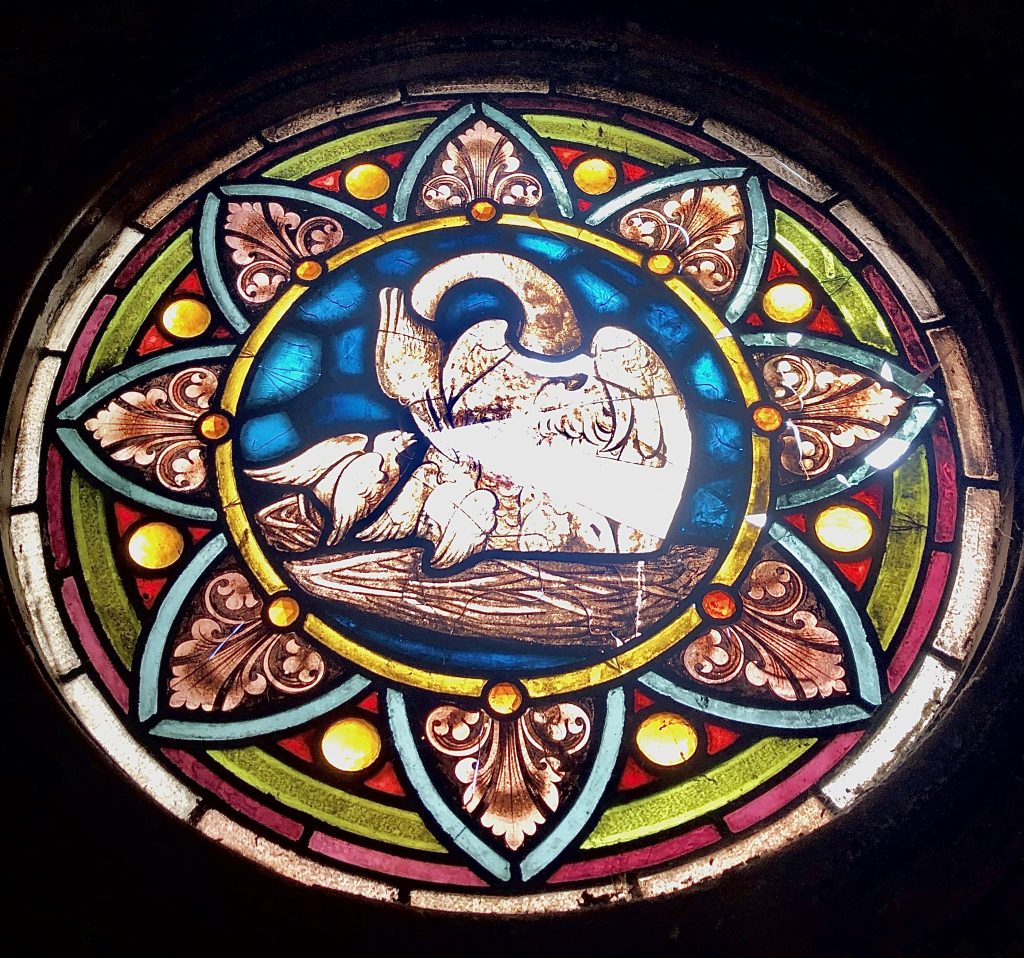
16. Table
The table is here to emphasize that the altar is always a table, for the sacrifice of animals and in Christianity the table of agape, the feast of love. It is the whole furniture of the church. This one was found on a sidewalk in front of a Taco Bell. I asked whether it was for sale, and it was. So I bought it for $100. It took six men to lift it.
17. & 18. Side Windows
Bruce made these windows when he was doing stained glass, and the colors match perfectly, though that was never intended. The angel heads in the windows are from the store called Mary’s Angels in Scotts Valley.